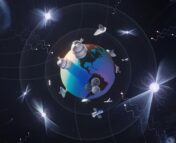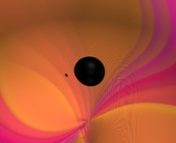by Sumeet Kulkarni and Jessie Thwaites
Contents

What are Gravitational Waves?
We’ll start our exploration of gravitational waves with Albert Einstein’s general theory of relativity, published in 1915. He said space and time were not separate entities, but intertwined into one continuum, the so-called fabric of spacetime. All massive bodies make this fabric bend and curve. In proposing this completely new theory of gravity, Einstein said gravity was not a force in space, but a manifestation of the curvature in spacetime. Specifically in the case of astronomy, massive bodies like stars, planets, and black holes curve spacetime in different ways and feel each other’s pull – and this interaction is through gravity.
John Wheeler’s famous quote summarizes this succinctly: “Spacetime tells matter how to move, matter tells spacetime how to curve.” Wheeler would later coin the term for objects so dense and massive, they curve spacetime to such extremes that even light cannot escape from them–’black holes’.
In weaving spacetime into a fabric, general relativity also rejects the notion that space is a rigid framework, or that time is absolute. Spacetime is allowed to stretch, squeeze, and swirl. Gravitational waves are ripples in spacetime predicted by general relativity to be emitted when massive bodies move around and perturb it in an asymmetric fashion – such as two stars orbiting each other, or a rapidly spinning potato. The effect, however, is so unimaginably miniscule that even Einstein thought it would be impossible to detect gravitational waves from Earth.
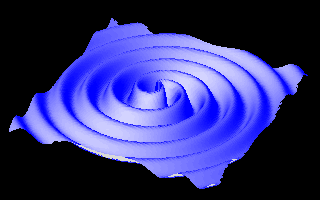
Image credit: NASA/JPL, Public domain, via Wikimedia Commons
But physicists revel in proving others wrong, be it Albert Einstein. The 1974 observation of the Hulse-Taylor binary pulsar saw its orbit shrink over the period of a decade in a manner exactly predicted by gravitational waves carrying away the binary’s energy and angular momentum. This indirect inference of gravitational-wave radiation was awarded the 1993 Nobel Prize in Physics.
Around the same time as the Hulse-Taylor binary pulsar’s discovery, physicists including Rai Weiss at MIT conceptualized giant laser interferometers that could directly detect gravitational waves. These would be emitted by the densest objects in the universe – neutron stars and black holes – spiraling into one another and colliding. Kip Thorne, a former graduate student of John Wheeler, led the effort in theoretically calculating the gravitational waveforms that these collisions would emit. With funding from the NSF, the Laser-Interferometer Gravitational-wave Observatory (LIGO) collaboration was born, with two detector sites at Livingston, Louisiana, and Hanford, Washington, built in the United States at the turn of the millennium. This first direct detection of gravitational waves, named ‘GW150914’ after the event date of September 14, 2015, was awarded the 2017 Nobel Prize in Physics. Since then, two other ground-based detectors, Virgo run by the European Gravitational-wave Observatory (EGO) in Pisa, Italy, and KAGRA in Japan have also joined forces.
The era of observing gravitational waves was furthered in June 2023 by the discovery of the low-frequency stochastic gravitational wave background by several Pulsar Timing Array teams around the globe. This discovery has enhanced our ability to study spacetime ripples across a complete spectrum of frequencies and timescales, allowing us to probe the universe to an even greater extent through this new window.
Finally, directly detecting gravitational waves allows us to study the universe at regimes where gravity warps space and time to its extremes. This enables us to put Einstein’s theory of general relativity itself to test, which could one day perhaps lead us to modify the fundamental theories of our universe.
A New Messenger
| Cosmic Rays (charged energetic particles) |
Gravitational waves (this Guide!) |
| Photons/light (electromagnetic radiation) |
Neutrinos (very small, neutral particles that interact rarely) |
The four messengers of our Universe. Dark matter may be added as a fifth messenger, but these are the four that have been directly detected thus far.
Multi-messenger astronomy refers to using multiple of the known messengers in the universe (cosmic rays, gravitational waves, electromagnetic radiation, and neutrinos) to measure a single object. Combining messengers like this gives us independent measurements of the same astronomical object, and can tell us loads of information about the processes happening at those objects.
Multi-messenger astronomy is a powerful tool to better understand our Universe. This tool has been successfully used in a few cases, leading to key discoveries about the nature of certain objects in our universe:
- Solar flares have been seen in both photons and cosmic rays
- A blazar, TXS 0506+056, was found to be flaring in both photons (gamma rays) and neutrinos
- Supernova 1987A (SN1987A) was observed in both photons and neutrinos (by the Kamiokande experiment, which had only just finished its upgrade in time to see the neutrinos).
The addition of gravitational waves as a messenger is akin to gaining one more sensory organ to understand our universe. This combination has already sparked a multi-messenger detection success story – the case of GW170817 and its photon counterparts.
GW170817 was a merger of two neutron stars observed by the LIGO-Virgo ground-based gravitational wave detectors detected on August 17, 2017. The LIGO-Virgo Collaboration sent this detection in real-time to the astronomical community through the Gamma-ray Coordinates Network (GCN) (GCN has now been revamped in an updated form as the “General Coordinates Network”). After sending the alert information to the community for additional follow-ups, Fermi-GBM sent an observation of a short gamma-ray burst, GRB170817A, which was coincident from the same area as the GW event and only 1.7 seconds after the merger time. A few hours later the first optical counterpart to a GW event was reported, SSS17a. The GCNs sent in real-time for this event can be found on the GCN Archive.
This was the first time an object was observed in both gravitational waves and photons, making it an exciting success story for multi-messenger astronomy! With the gravitational wave information we gained insight into the system before and during the merger (such as the masses of the progenitor neutron stars) and with the electromagnetic detection astronomers saw the kilonova and were able to localize in which galaxy the merger happened!
Sources of Gravitational Waves
There are a few different sources of gravitational waves, some of which have been observed (e.g. compact binary mergers involving neutron stars or black holes by LIGO-Virgo detectors) and some of which are mostly theoretical objects. Below are some examples of these different types of sources!
Compact Binary Mergers
When talking about observing gravitational waves, we hear a lot about compact objects – black holes, neutron stars, and white dwarfs. So what are each of these objects?
- Black holes are essentially a single point with an extremely strong gravitational pull – so strong, that not even light can escape! At a particular radius (the Schwarzchild radius), no information (including light) can escape, since the escape velocity from the black hole inside that radius exceeds the speed of light. The sphere described by this Schwarzchild radius is called the event horizon of the black hole.
- Neutron stars are formed when a star goes supernova. Core-collapse supernovae (CCSNe) leave a neutron star as a remnant when a massive star (>8 solar masses) collapses in on itself. They are extremely dense (usually on the order of 10^17 kg/m^2, compared to the Earth’s density at around 5 x 10^3 kg/m^2), and generally can have a mass between about 1.1 to around 2 solar masses (this is determined by the Tolman–Oppenheimer–Volkoff limit) with a diameter of only 10-20 km.
- White dwarfs are formed when low to intermediate mass stars no longer have enough energy to continue the fusion process, and the star then collapses into itself. These objects are also incredibly dense (around 10^9 kg/m^2), and are lower mass than neutron stars, weighing in at a fraction of a solar mass (~0.15) up to 1.4 solar masses (the upper limit for white dwarf masses is determined by the Chandrasekhar limit).

In space, all objects are constantly interacting with each other through gravity. However, to observe gravitational waves we often discuss these compact objects, because they are extremely dense and have an enormous gravitational pull on objects around them, meaning they cause the most deformation to the fabric of spacetime around them, and so the strongest gravitational waves.
One type of gravitational waves we can observe is from the merger of two such compact objects. Whenever two of these objects orbit one another in a binary system, as they get closer together (this is called an inspiral) and eventually merge, their gravitational waves can be observed by gravitational wave detectors.
Figure 2 is an illustration of two compact objects merging. At the beginning of the time scale, the objects are spiraling in towards each other, and the mostly constant frequency gravitational waves can be seen in the middle panel. As the objects get closer together, between 0.35-0.40 s on the timescale, the wave peaks are getting closer to each other (this means the period is decreasing, which simultaneously means that the frequency is increasing). When they merge (at about 0.42 s), we see the period get extremely short, at the same time the strain reaches its maximum value. After the merger, the wave is rapidly damped in a stage called ringdown.

This type of gravitational wave event involving two black holes was first observed by ground-based laser interferometers (see this section later within this guide), in 2015 by the LIGO-Virgo Collaboration. So far, compact binaries are the only source of gravitational waves that we have directly detected. The first detection was followed by two more events involving merging binary black holes in O1, LIGO’s first observing run which lasted until the spring of 2016.
In its second observing run (O2) in 2017, the twin LIGO detectors were joined by Virgo, the European gravitational-wave detector in Pisa, Italy. Three-gether, they detected a new kind of compact binary merger, this time involving the collision of two neutron stars (see the earlier section describing GW170817!). Unlike black hole collisions which are not known to give out any light, this particular event was followed by cosmic fireworks as the neutron stars tore each other apart while merging, and ejected matter that radiated in gamma rays and X-rays, followed by a kilonova afterglow and ultraviolet, visible, and radio wavelengths of the electromagnetic spectrum. This was a true multi-messenger event that provided a wealth of information about the formation of heavy elements such as gold and platinum, and the fact that gravitational waves travel at the speed of light.
Continuous Gravitational Waves
A compact object does not always need a partner to emit gravitational waves by dancing around one another. Any object in motion can create these waves, but this motion has to be asymmetric, with a so-called quadrupole moment. So while a perfectly spherical spinning star or a black hole cannot radiate gravitational waves, a rapidly spinning compact potato can. While there’s no evidence for spinning spuds in space, we do know about pulsars, which are rapidly rotating neutron stars that send out lighthouse-like beams of radio waves.
Such rotating neutron stars can be a potential source of gravitational waves if they are not perfectly spherical. But any deformation on a neutron star is likely not in the form of mountains and valleys given their extreme gravitational pull that can make the toughest materials collapse. In fact, the tallest hypothetical mountain on a neutron star can only tower at a fraction of a millimeter in height! Neutron star deformations, then, can be thought of as mere deviations from a perfect sphere to an ellipse, measured by a quantity known as ellipticity.
Given a fast spinning neutron star with an ellipticity, it can wobble around its spinning axis, emitting gravitational waves which have twice the frequency of this wobble. Unlike binary mergers in which the waves come in quick and relatively loud chirps, gravitational waves from isolated sources would be very faint and persist as long as the neutron star is wobbling. These ‘Continuous gravitational waves’ are searched for in every LIGO-Virgo observing run, both for pulsars that we already know of and for unknown ones in our neighborhood. So far, no continuous wave source has been confirmed. But the non-detection of gravitational waves from known pulsars lets us put constraints on their ellipticity and in turn estimate the heights of the tallest mountains therein.
Stochastic background
When crickets first start chirping in the evening, we can hear the individual early-callers searching for a mate. As the night rolls in, the sound of innumerable chirps blends into a noise permeating throughout the forest. As we build more sensitive gravitational wave detectors, we may start hearing a similar background noise caused by gravitational-wave chirps. This is called the Stochastic Gravitational Wave Background. So far, LIGO and Virgo have not detected such a background from the merger of stellar mass compact objects. But when it comes to supermassive black hole mergers, Pulsar Timing Arrays (read more below!) have been successful at catching these combined whispers!
Primordial Gravitational Waves
Primordial gravitational waves have a name which describes their origin: these are gravitational waves that were produced very shortly after the Big Bang, during the period of accelerated expansion known as inflation. These would have been produced on similar timescales to the Cosmic Microwave Background (CMB), and would be a key piece of proof for inflation.
During inflation, there were small mass and energy fluctuations, which produce these primordial gravitational waves as well as seeded the universe as we see it today. These waves would have extremely small frequency (huge wavelength), which puts them outside the range of frequencies which current gravitational wave detectors can detect. Even if detectable, these primordial gravitational waves are theorized to overlap with the stochastic background, adding another challenge to observing these type of gravitational waves.
Other Exotic Sources
A number of other ideas exist for the astrophysical emission of gravitational waves. Stars made out of exotic, dense matter such as quark stars may emit continuous or transient gravitational waves much like neutron stars or black holes. Another popular idea is the interaction of dark matter particles such as axions with spinning black holes. This scenario can effectively create “gravitational atoms” with the black hole at the center, and axions orbiting like electrons and gaining momentum via superradiance interactions and reducing the black hole spin. Signatures of this spin-down or that of the transitions of bosons themselves within orbital levels can be detected through gravitational waves; LIGO-Virgo can establish constraints on these interactions in their detections, which will be further fine-tuned by space-based detectors like LISA.
The Gravitational Wave Spectrum
The wide array of gravitational wave sources discussed above all emit these waves at different frequencies. Hence, much like the electromagnetic spectrum that extends from radio waves at long wavelengths to gamma rays at the shortest wavelengths with the rainbow of visible light in the middle, we can map out everything that beats the drums of spacetime in a gravitational wave spectrum. This ranges from waves spanning several light years due to the motions of supermassive black holes, to “shorter” bursts having wavelengths of the order of kilometers emitted by colliding stellar mass black holes and neutron stars. Correspondingly, the perturbations of spacetime due to these waves can occur over timescales of several years to a few seconds. The challenge, then, is to come up with ways to detect this wide variety of gravitational waves, while keeping in mind that their physical magnitude as they reach the Earth are still impossibly tiny.
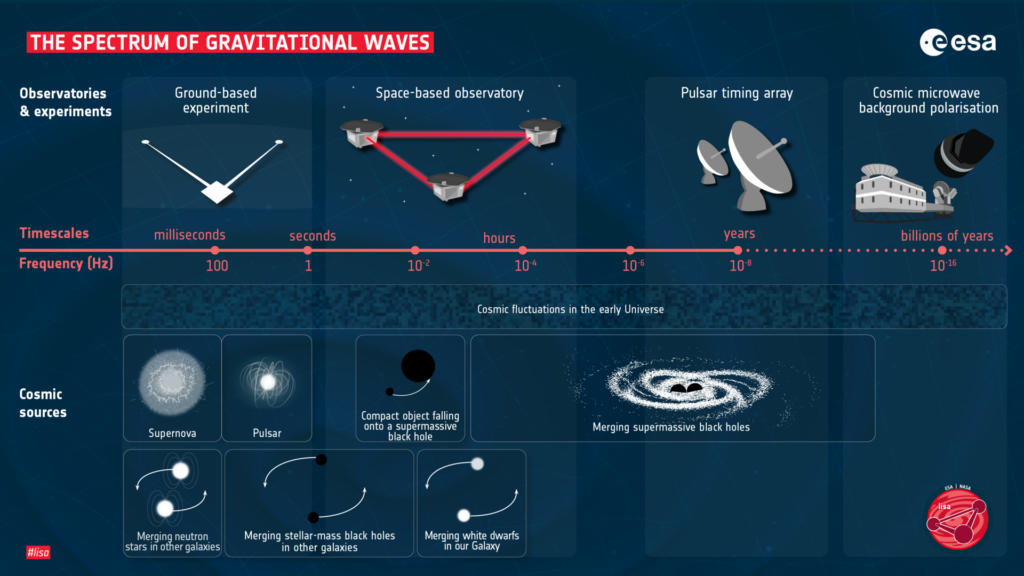
Detecting Gravitational Waves
Imagining the existence of gravitational waves itself is a wild endeavor. But our attempts at designing the scientific instruments to detect them, whether successful or unsuccessful, whether a promising work in progress or a literal shot in the dark, have possibly been wilder.
Laser Interferometers
How can we detect tiny distortions in space-time caused by gravitational waves? One solution that has so far been very successful is using interferometry – essentially using interference patterns from lasers to distinguish the distortions from gravitational waves passing through the detector. So, how does an interferometer work, and how has it been used in the context of gravitational waves?
Interferometers work by merging two or more sources of light to create an interference pattern, which can be used to make incredibly small measurements. A sample diagram of the LIGO interferometer can be seen in Figure 3.
In a gravitational wave detector, the interferometer is set up so that the two beams completely destructively interfere, so that there is only a signal when a gravitational wave distorts the beam by changing the length of each of the arms. This allows us to “see” the gravitational wave most clearly. This is called direct detection of gravitational waves, since we are seeing the waves themselves in the distortions of the detector.
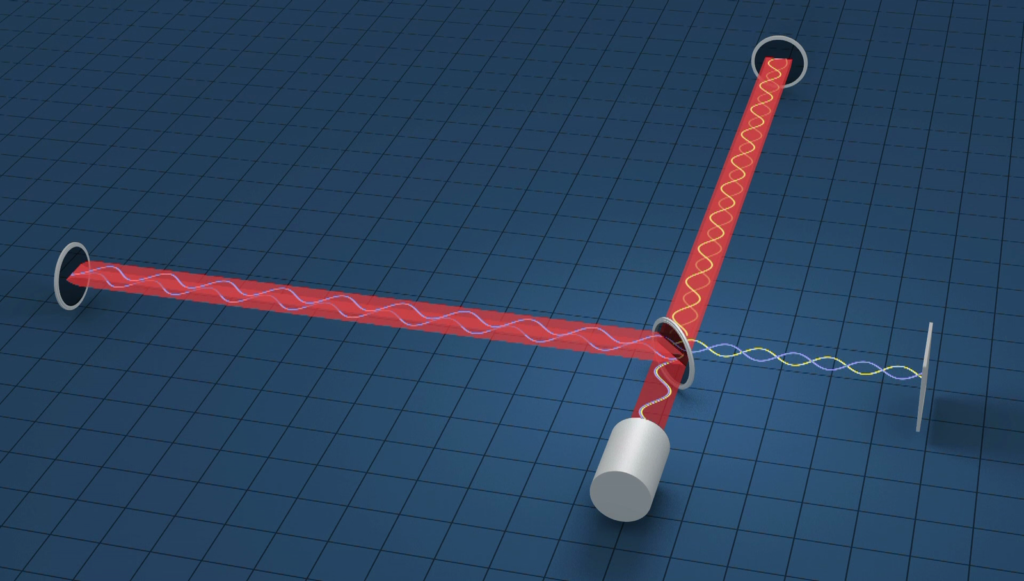
Interferometers can be ground-based or space-based, so we’ll discuss both in the sections below.
Ground-based – LIGO, Virgo, and KAGRA (LVK)
Ground-based gravitational wave direct detection is the main mechanism used thus far to detect gravitational waves from compact binary mergers. Each of the detectors has its own laser interferometer, which has two 4km long arms to make an L-shape. However, 4 km is not long enough to significantly measure the tiny signals from space-time being distorted by a gravitational wave. To solve this issue, the light is reflected in each arm in a Fabry-Perot cavity up to 300 times, increasing the distance the light travels before interfering to 1200 km.
The three names (LIGO, Virgo, and KAGRA) refer to 3 collaborations of gravitational wave detectors. The Laser Interferometer Gravitational-wave Observatory (LIGO) is a set of two detectors in the US, one in Livingston, Louisiana and another in Hanford, Washington. Virgo has an interferometer just outside of Pisa, Italy, and KAGRA has an interferometer in the Kamioka mine in Japan.
One of the challenges of gravitational wave observation is localizing the source of the gravitational waves. The way this is done is comparing timing information between the observation of the GW event in different detectors. A (very small) shift in the time the event is observed at the detector due to the finite speed of gravitational waves (the same as the speed of light) allows for the gravitational wave to be localized on the sky.
With two detectors, the GW can be localized to a large banana-shaped region of the sky, but with the addition of a third (or more) detector(s) this can be dramatically improved, as can be seen in the sizes of the regions shown in Figure 4. The highlighted regions show the areas where the merger could lie, which for two detectors are large portions of the sky but are massively improved by the addition of the Virgo detector for the 2 latest GWs in the image, GW170817 and GW170814.
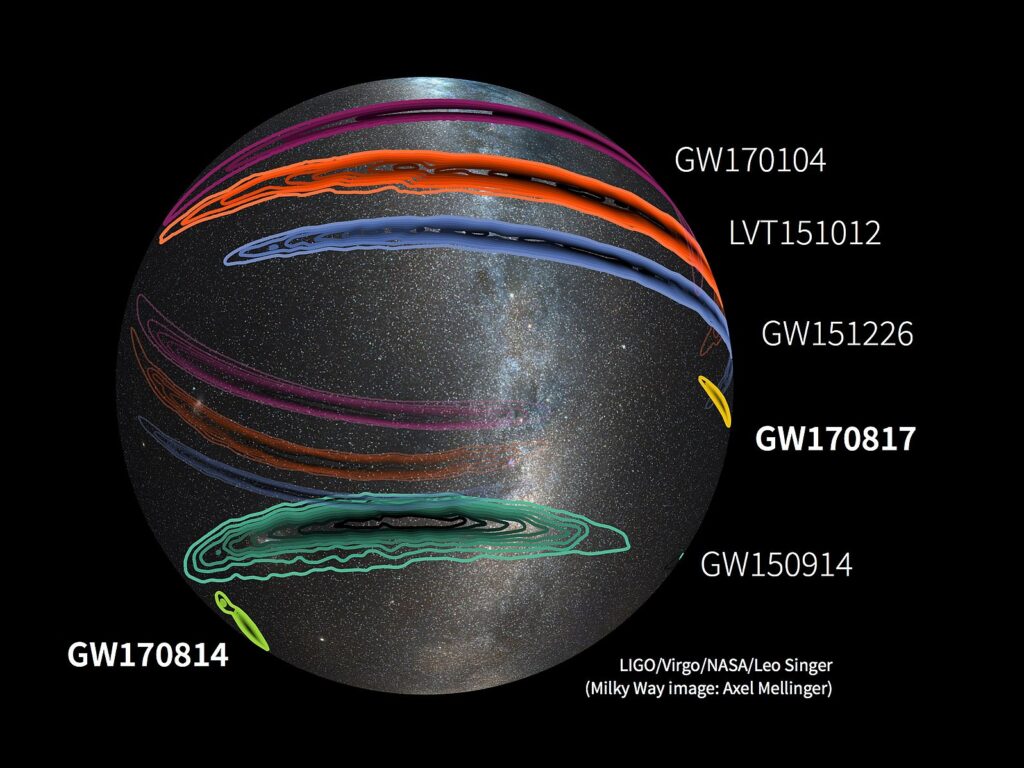
Space-based
But why restrict ourselves to only terrestrial detectors? What happens if we build a detector in space?
That’s exactly what the planned first space-based gravitational wave detector, the Laser Interferometer Space Antenna, LISA, will do. LISA is a mission led by the European Space Agency (ESA), with support from ESA member states and NASA. It will consist of three satellites, arranged as the same type of interferometer as LIGO, Virgo, and KAGRA (LVK) detectors.

There are, of course, challenges to building in space, but there are significant benefits to having the detector in space. The arm length of LISA will be 2.5 million kilometers – 2000 times longer than the ground based detectors. This will make LISA sensitive to gravitational waves at much smaller frequencies than the LVK detectors, opening the window to new types of gravitational wave sources such as supermassive black hole binaries and extreme mass ratio inspirals (EMRIs), and variety of other astrophysical sources. In fact, there will be so many overlapping signals detected with LISA that one of the key problems currently being worked on is how to disentangle all of these.
Pulsar Timing Arrays
Pulsars – rapidly spinning neutron stars that emit beamed pulses of radio waves – are some of the most accurate timekeepers in the universe. Their incredibly predictable and accurate beaming of signals like a lighthouse make pulsars a valuable tool in studying variations in the fabric of spacetime. Tracking the rotational period and shrinking orbit of the aforementioned Hulse-Taylor binary pulsar lead to the first evidence of gravitational waves. Now, astronomers are keeping track of a collective bunch of pulsars spread around the galaxy to see if passing gravitational waves coherently affect the ticking of their clocks. Known as Pulsar Timing Arrays (PTAs), these observations are carried out by collaborations of astronomers using a number of radio telescopes around the world. Prominent among these are NanoGrav, the International Pulsar Timing Array (IPTA), the Indian Pulsar Timing Array (InPTA), and the European Pulsar Timing Array (EPTA).
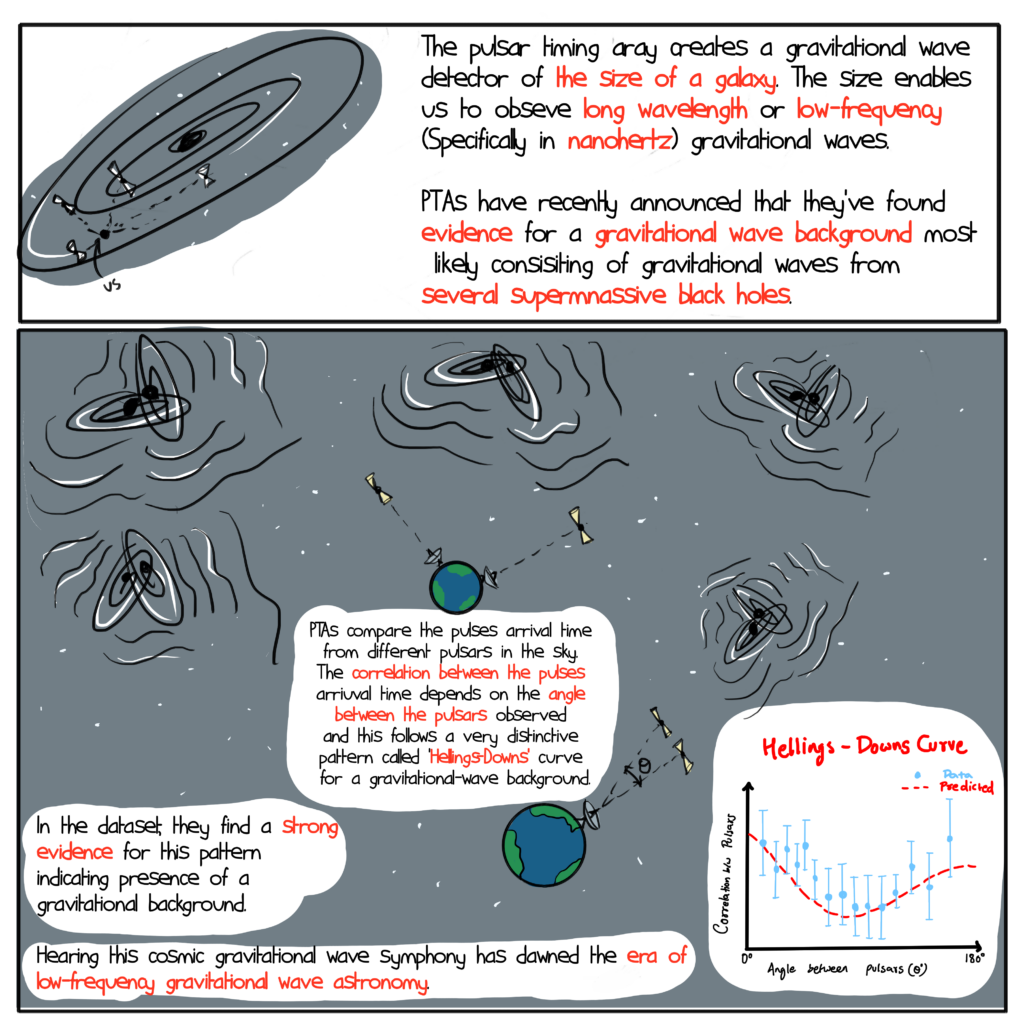
Instead of detecting individual gravitational wave events such as compact object mergers detected by ground-based interferometers, PTAs have the ability to pick out the stochastic gravitational-wave background of all these events humming in unison. To do so, NANOGrav has kept track of over 50 Millisecond Pulsars (MSPs) spread throughout the milky way, which emit pulses in the millisecond timescale, using the Green Bank telescope and the Arecibo observatory for over a decade. Because each pulsar acts like a probe for gravitational wave detection, PTAs like NANOGrav can be thought of as galaxy-sized detectors. To learn more about the theory behind PTAs and the stochastic background, check out this astrobite about a seminal paper in this field.
Detecting the Gravitational-wave Background through pulsar timing takes years of observations. NANOGrav reported finding hints of this in an analysis of their 12.5-year dataset in 2021. It took two further years for this signal to be confirmed (with the addition of other PTA collaborations) as an astrophysical bassline hum in the groundbreaking announcement made in June 2023.
The most likely cause of this background is the collective rumble of many supermassive black holes merging when galaxies collide. If confirmed to be true, this observation is of theoretical significance. We have observed galaxies coming together, but there lies a barrier between this and their central black holes merging. As galaxies collide, stars get slingshot out of the gravitational fields of the black holes, pulling them closer. But this happens only until they’re within around one parsec of each other, a little over the distance between the Sun and its nearest star. Beyond this, there are no more stars to carry energy away, and something else is needed to pull the black holes closer before gravitational radiation takes over and completes the job. Else, they would happily orbit each other for eternity. This is known as “the Final Parsec problem”; Observing SMBH mergers means some mechanism does play an intermediate role, and leaves more questions for us to answer!
Other methods
The first-ever gravitational wave detector could fit atop a large dining table. This was the Weber bar – literally a large and heavy chunk of metallic cylinder, usually aluminum, named after its inventor, University of Maryland physicist Joseph Weber. These bars had a finely-tuned resonance frequency of around 1 kilohertz. Weber bars worked on the principle that any vibrations caused by gravitational waves would disturb the resonant frequency and be measurable using piezo-electric sensors. In reality, the huge surplus of environmental vibrations and thermal noise meant that even more advanced heavier and cryogenically cooled bar detectors never achieved the sensitivity to detect gravitational waves.
A unique way to try and detect gravitational waves as a ‘by-product’ sending and receiving radio pulses from interplanetary spacecraft such as Cassini (Saturn) and Juno (Jupiter), and checking whether there is any deviation from the expected spacecraft location. These essentially act as an interferometer with one arm, making it a neat way to utilize the space probes during their decades-long travel time across the solar system.
Another indirect way of detecting gravitational waves is by monitoring the precise astrometry or positions of stars in sky surveys such as Gaia. Given how precise these surveys are, any correlated perturbation in the sky position of stars due to gravitational waves could be potentially detectable.
Looking ahead
As we can see from this Guide, the field of gravitational wave astronomy has truly broken open over the past 50 or so years. Gravitational wave astronomy has already been awarded 2 Nobel Prizes (indirect detection in 1993 and direct detection in 2017).
With the groundbreaking announcement of the detection of the gravitational wave background, we are in the midst of an exciting era of low-frequency gravitational wave astronomy! On the higher frequency end of the spectrum, the LIGO-Virgo-KAGRA detectors are currently running for their joint fourth observing run O4, which started in May 2023, with improved sensitivity and many upgrades to the instruments. The addition of LISA will provide a new window to different sources of gravitational waves than can be seen by LVK, and additional detectors targeting other sources of gravitational waves can tell us lots about our universe.
From cosmology to gravitational lensing, testing the original theory of General Relativity to understanding the properties and origins of each of the sources, gravitational wave astronomy opens up many more scientific questions to explore. Gravitational wave astronomy is an exciting field, and provides an important new messenger to understanding our universe, both at its earliest timescales and in events occurring in the present.
Editors: Storm Colloms, Sabina Sagynbayeva
Featured Image Credit: NASA’s Scientific Visualization Studio – Krystofer Kim, Barb Mattson, Scott Wiessinger, Barb Mattson, Scott Wiessinger, Paul Morris, Chris Smith, Public domain, via Wikimedia Commons


